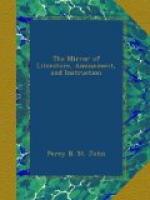[8] All this must be understood with some limitations, otherwise we must suppose that all the inhabitants of Egypt had not only learned to write, but that they had sufficient talents and knowledge of the laws, to draw up their own defences, which is not to be supposed. This law then must have been liable to some exceptions and modifications. We must say the same thing of other countries where they tell us there are no advocates, and that all trials are carried on in writing, as in Siam, China, Bantam, &c. Origin of Laws, G.M. Gognet.
* * * * *
THE TOPOGRAPHER.
* * * * *
CLIFTON HOT WELLS.
(For the Mirror.)
Glide, Avon, gently glide....
More prodigal in beauty than the dreams
Of fantasy,... beneath the chain
Of mingled wood and precipice, that seems
To buttress up the wave, whose silvery
gleams
Stretch far beyond, where Severn leads
the train.
Gilpin says, and says truly, that “the west is the region of fine landscape;” it also follows as a natural consequence that it predominates in the number of its artists. The beautiful vignette of Clifton in a recent number of the MIRROR,[9] has recalled a multitude of interesting recollections to my mind. I have passed a good deal of time there at several periods, and as the writer of the description accompanying the vignette has been led into an error or two, perhaps a few desultory notes by way of pendant to his paper, may not be entirely devoid of interest to the reader.
[9] See MIRROR, No. 390.
The old Tower on the Downs no longer exists. A Tower designed for an observatory has been erected near its former site, which is fitted up with several large telescopes, and a camera obscura, to which the public are admitted. This Tower which is seen in the engraving, stands, as stated, on an extensive Roman camp, or fortification. It would have been difficult to have selected a more appropriate situation for such a building; for the combination of picturesque and sublime scenery, united with the beauties of art, is no where more enthrilling to the mind than at Clifton.




